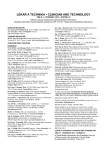Knowledge Modeling of Agile Processes in Healthcare Systems Development
Authors:
Michal Košinár
Authors‘ workplace:
Department of Computer Science, VŠB – Technical University of Ostrava, Faculty of Electrical Engineering and Computer Science
Published in:
Lékař a technika - Clinician and Technology No. 4, 2013, 43, 32-35
Category:
Original research
Overview
Requirements on healthcare software products are becoming more and more complicated and software systems of today are characterized by increasing complexity and size. Therefore, software systems can no longer be developed feasibly without the processes supported by appropriate methods. We propose a method for configuration and modification of agile processes behind healthcare products development based on gathered knowledge and formal modeling. Our approach allows to support and optimize the processes with formal methods of modeling and machine-learning based simulations.
Keywords:
Healthcare information systems, software products, SCRUM, agile, OWL, TIL, PROLOG, formal systems, Petri Nets
Sources
[1] K. Beck. Extreme Programming Explained: Embrace Change. Addison-Wesley, 2000. ISBN 0201616416.
[2] J. Highsmith and A. Cockburn. Agile software development: the business of innovation. Computer, 34(9):120–127, 2001.
[3] I. Vondrák. Methods of Business Modeling. VŠB-TUO, Czech Republic, Ostrava, 2004.
[4] M. Duží, M. Košinár, J. Kožusznik, S. Štolfa (2012) Knowledge-base approach to software process development based on TIL.
[5] Scacchi W, Mi P (1997) Process Life Cycle Engineering: A Knowledge-Based Approach and Environment. Intelligent Systems in Accounting, Finance, and Management 6 : 83--107-183--107.
[6] Workflow Management Coalition: http://www.wfmc.org/ WfMC Web, 1999.
[7] Machado EP, Caetano Traina J, Araujo MRB (2000) Classification Abstraction: An Intrinsic Element in Database Systems. Paper presented at the Proceedings of the First International Conference on Advances in Information Systems.
[8] Scacchi W (1999) Experience with software process simulation and modeling. Journal of Systems and Software 46 (2-3):183-192.
[9] K. Schwaber. Agile Project Management with Scrum. Microsoft Press, 2003. ISBN 0-7356-1993-X.
[10] Scrum. Control Chaos: Scrum. Internet, 2006. URL http://www.controlchaos.com/. Referenced 22.11.2006.
[11] Vondrák, I.: Neural networks (czech). VŠB-TUO, Czech Republic, Ostrava, revision 2009.
[12] W3C (2009) OWL 2 Web Ontology Language. http://www.w3.org/TR/owl2-overview/.
[13] Object Management Group(OMG) (2010) OMG Unified Modeling Language(OMG UML), Infrastructure, Version 2.3.
[14] Hug C, Front A, Rieu D, Henderson-Sellers B (2009) A method to build information systems engineering process metamodels. Journal of Systems and Software 82 (10):1730-1742. doi:10.1016/j.jss.2009.05.020
[15] Karkoška, T.: Vytvoření nástroje pro podporu tvorby ontologií v multi-agentním prostředí. Diploma thesis, VŠB-TUO, Czech Republic, Ostrava, 2008.
[16] Allemang D, Hendler J (2008) Semantic Web for the Working Ontologist: Effective Modeling in RDFS and OWL.
[17] Laurent J-P, Ayel J, Thome F, Ziebelin D (1984) Comparative Evaluation of Three Expert System Development Tools: Kee, Knowledge Craft, Art. The Knowledge Engineering Review 1 (04):18-29. doi:doi:10.1017/S0269888900000631.
[18] Garg PK, Scacchi W (1989) ISHYS: Designing an Intelligent Software Hypertext System. IEEE Expert: Intelligent Systems and Their Applications 4 (3):52-63.
[19] Mi P, Scacchi W (1990) A Knowledge-Based Environment for Modeling and Simulating Software Engineering Processes. IEEE Trans on Knowl and Data Eng 2 (3):283-294. doi:10.1109/69.60792.
[20] Mi P, Scacchi W (1996) A meta-model for formulating knowledge-based models of software development. Decis Support Syst 17 (4):313-330. doi:http://dx.doi.org/10.1016/0167-9236(96)00007-3.
[21] Morgan Kaufmann. Silver GA, Lacy LW, Miller JA (2006) Ontology based representations of simulation models following the process interaction world view. Paper presented at the Proceedings of the 38th conference on Winter simulation, Monterey, California.
Labels
BiomedicineArticle was published in
The Clinician and Technology Journal

2013 Issue 4
Most read in this issue
- Vývojové poruchy zubů a jejich diagnostika pomocí rentgenových snímků
- Metodika merania na celotelovom 3D skenery a možnosti aplikácie
- Termografické hodnocení radiofrekvenční ablace stentů ex vivo
- Utilizing of MEMS sensors in rehabilitation process
